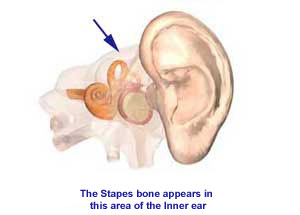Otosclerosis
Otosclerosis may cause hearing impairment. Otosclerosis means hardening of the bone of the ear. Approximately one-third of all persons with impaired hearing have this condition. Since otosclerosis is hereditary, someone in your family may have this condition and could have passed it down to you. You may not be aware of the presence of the hearing loss in your family because it may date back many generations. The fact that you have otosclerosis does not necessarily mean that your children will be affected. Despite the fact that otosclerosis is hereditary, a condition called German measles may have a relationship in its development.
Sound vibrations normally are transmitted from the eardrum to the inner ear by three small ear bones. When the middle ear bones (malleus, incus, and stapes) move, they change sound vibrations in the air into fluid waves in the inner ear. The fluid waves stimulate delicate nerve endings in the hearing canal. The hearing nerve then carries nerve impulses to the brain; the brain interprets the impulses as understandable sound. The stapes (third middle ear bone) is the final link in this transformer chain. It rests in a groove called the “oval window,” in close contact with the inner ear fluids. Anything that interferes with its movement will cause loss of hearing.

Symptoms
Head noise, or tinnitus, frequently develops in patients with otosclerosis, due to irritation of the delicate nerve endings. Since the nerve carries sound, this irritation causes ringing, roaring or buzzing. It is usually worse when the patient is tired, nervous or in a quiet environment. The amount of tinnitus is not necessarily related to the degree of hearing loss. The ability of the hearing nerve to carry sound to the brain may gradually lessen over a period of years. This loss of nerve function, once it develops, is permanent. The amount of hearing loss caused by the hardening stapes, and the nerve damage, can only be determined by careful hearing tests.
Treatment
There is no medication that will improve the hearing in persons with otosclerosis. However, sodium fluoride may prevent progression of hearing loss in some patients. A hearing aid is often a treatment option.
Stapes Operation
The stapes operation is recommended for patients with otosclerosis who are candidates for surgery. This operation is performed under local or general anesthesia and requires a short recovery period. For the stapes operation to be successful in restoring hearing to patients with otosclerosis, the hearing nerve must be able to receive and transmit sound to the brain. Careful and thorough hearing tests are necessary to determine the hearing nerve function.
With any ear operation, there is a chance that the hearing could worsen or be lost altogether. The possibility of this happening differs from one operation to another and may occur even if the surgery goes well.
In stapes surgery, the eardrum is raised under anesthesia. The fixed stapes is removed gently . A new stapes made of wire is placed into position over the inner ear fluid. The eardrum is then repositioned. In some special cases, laser surgery is performed. The new stapes allows the sound vibrations to again pass from the eardrum to the inner ear. This new stapes does not tend to reattach to the surrounding bone, and the hearing improvement obtained is usually permanent.
The patient having stapes surgery may be hospitalized overnight. Depending upon the patient’s type of work, time out of work varies from two to six or seven days. There may be a slight dizziness on sudden head motion for several weeks. There may be a taste disturbance immediately following surgery. This goes away within two or three weeks in most cases.
Hearing improvement may or may not be noticeable at the time of operation. If hearing improves at the time of surgery, it usually goes away in a few hours, due to the swelling in the ear. Improvement in hearing will usually be apparent within three weeks following surgery. Maximum hearing is obtained in approximately four months. If the stapes surgery is not successful, the hearing usually remains the same as before the operation. In most instances, the surgery may be repeated with a good chance of a successful result.
In two percent of the cases, the hearing may worsen in the operated ear. In one percent of cases, there may be a severe loss of hearing in the operated ear. In this event, the head noise may be more severe, dizziness may persist for some time, and one may not be able to benefit from a hearing aid in the operated ear. For this reason, the poorer ear is usually selected for surgery.
If you are a suitable candidate for surgery and do not have the stapes operation at this time, it is advisable to have careful hearing tests repeated at least once a year.
Hearing Aids
If you are a suitable candidate for surgery, you are also suitable to benefit from a properly fitted hearing aid. If you have otosclerosis and are not suitable for stapes surgery, you may still benefit from a properly fitted aid. Patients with otosclerosis will usually be able to hear with an electronic aid, and seldom go deaf. The older the patient, the less the tendency for further hearing loss due to the hardening process of otosclerosis.
For more information:
Go to the Ear, Nose, and Throat Disorders health topic.